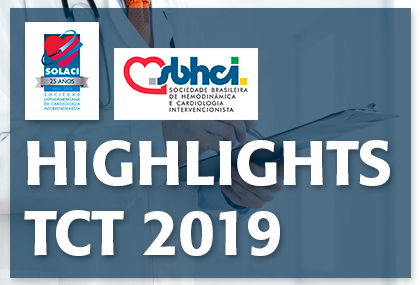Courtesy of SBHCI. Patients with severe aortic stenosis and low surgical risk showed decreased mortality, stroke, and heart failure hospitalization at one year with transcatheter aortic valve replacement compared with surgery. Improved quality of life may seem an obvious consequence, but until now that was mere speculation. This work, presented at the TCT 2019 Scientific Sessions…
TCT 2019 | SCOPE I: Self-Expanding Valve Acurate Neo Head to Head with Sapien 3
Courtesy of SBHCI. This work, which was presented during the TCT 2019 Scientific Sessions and simultaneously published in the Lancet, randomized patients to the ACURATE Neo prosthesis (n = 373) vs. the SAPIEN 3 (n = 367) in a head-to-head comparison involving 20 European sites. Transfemoral access was used in all patients. The study had a noninferiority design, and its primary…
Experts Reach Consensus on Post TAVR Pacemaker Indication
This new consensus published this week in J Am Coll Cardiol has provided us with an algorithm to manage conduction disturbances after transcatheter aortic valve replacement. This consensus is intended to reduce potential deaths caused by conduction disturbances and, at the same time, reduce unnecessary definite pacemaker implantation. This document is a big step ahead…
FDA Expands TAVR Indication to Low-Risk Patients
Both the self-expandable valve Evolut R and its direct competitor, balloon-expandable valve Sapien 3, received the authorization to be indicated for low-risk patients in a long-awaited announcement made on August 16th, 2019. The US Food and Drug Administration (FDA) has approved and expanded the indication for the Evolut series (Medtronic) and the Sapien 3 and…
Clinical Implications of the New Hypertension Guidelines
Hypertension is the first modifiable risk factor affecting morbidity and mortality in nearly half of the adults in the US. The new ACC/AHA guidelines have issued new standards for the detection assessment and management of high blood pressure. The major change compared against their prior version was stage 1 hypertension definition, defined as systolic blood…
Next-Day Discharge after TAVR: Equally Safe for All Prosthesis?
Yet scarce, there is evidence supporting next-day discharge (NDD) after TAVR is safe when patients receiving balloon expandable valves meet certain conditions. This had not yet been shown for self-expandable valves. This study looks into NDD after TAVR by femoral access with self-expandable valves. The authors retrospectively compared all consecutive patients undergoing elective minimalist TAVR…
Prosthetic Valve Endocarditis and TAVR: though Rare, Devastating
On the bright side, the incidence of prosthetic valve endocarditis (PVE) post TAVR is not higher than post SAVR, according to this study recently presented at EuroPCR 2019, held in Paris. There is plenty of evidence describing PVE incidence, prognosis, risk factors, etc. after surgical valve replacement surgery (SAVR). However, we know little about the…
Pulmonary Hypertension: No Reason for TAVR Contraindication
In most severe aortic stenosis patients with pulmonary hypertension, transcatheter aortic valve replacement (TAVR) reduced pulmonary systolic pressure. There patients presented lower risk and lower all-cause mortality at short, median and long term. This data show that pulmonary hypertension should not be a TAVR contraindication. Pulmonary hypertension is common among TAVR patients. The most frequent…
Low-Risk TAVR Trending in All Papers
Transcatheter aortic valve replacement (TAVR) in low-risk patients with symptomatic severe aortic stenosis appears to be safe at one year. In a follow-up using computerized tomography (TC), hypoattenuated leaflet thickening was observed in a minority of patients, but it did not have a long-term hemodynamic impact. It should be noted that the management strategy for…
Safe for 80-Year-Olds. Should Nonagenarians be Withheld from TAVR?
According to this large global registry, mortality after transcatheter aortic valve replacement (TAVR) is twice as high in nonagenarians as against the “younger” group (90 patients. Additionally, risk scores cannot be trusted given that on the one hand they were designed for patients with planned surgery, and on the other hand, they included few patients…









